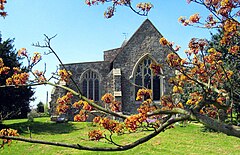High Halstow
| High Halstow | |
|---|---|
 The 10th-century St Margaret's Church, High Halstow, looking east |
|
| High Halstow shown within Kent | |
| Population | 1,807 (2011) |
| OS grid reference | TQ780754 |
| Civil parish |
|
| Unitary authority | |
| Ceremonial county | |
| Region | |
| Country | England |
| Sovereign state | United Kingdom |
| Post town | ROCHESTER |
| Postcode district | ME3 |
| Dialling code | 01634 |
| Police | Kent |
| Fire | Kent |
| Ambulance | South East Coast |
| EU Parliament | South East England |
| UK Parliament |
|
High Halstow is a village and civil parish on the Hoo Peninsula in the unitary authority of Medway in South East England. It was, until 1998, administratively part of Kent and is still ceremonially associated via the Lieutenancies Act. The parish had a population of 1,781 according to the 2001 census, increasing to 1,807 at the 2011 census.
Originally known as Hagelstowe (in Textus Roffensis), Hagelsto or Agelstow, it was named from an Old English word denoting a high, holy place. The area has been occupied by Romans, Saxons and Normans.
The village lies on the junction of the ancient roads from Hoo and Cliffe to the Isle of Grain, now a crossroads to the north of the A228 road. One of the highest points on the Hoo peninsula, at 30 to 50 metres above sea level, the modern village consolidates into a single community the four hamlets of Clinch Street, Fenn Street, Sharnal Street and High Halstow Street.
The 10th-century Grade I listed church of St Margaret at High Halstow was mentioned in the Domesday Book of 1086, and was built on the highest point of the Hoo Peninsula, overlooking the rivers of the Thames and Medway.
In the 18th century poverty and malnutrition were widespread across the peninsula, with High Halstow no exception; adult life expectancy was then about 30 years, lessened by ague, or marsh fever, the names for malaria, which proliferated in the North Kent Marshes and waterlogged farmland, a stronghold of the mosquito. The cause of malaria was discovered in 1890, and within five years the number of people falling ill with the disease decreased sharply as farmland and marshes were drained. This task was performed in no small way by Henry Pye, after he moved to the area.
...
Wikipedia

